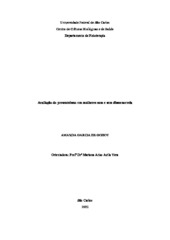| dc.contributor.author | Godoy, Amanda Garcia de | |
| dc.date.accessioned | 2022-03-04T13:02:43Z | |
| dc.date.available | 2022-03-04T13:02:43Z | |
| dc.date.issued | 2022-02-07 | |
| dc.identifier.citation | GODOY, Amanda Garcia de. Avaliação do presenteísmo em mulheres com e sem dismenorreia. 2022. Dissertação (Mestrado em Fisioterapia) – Universidade Federal de São Carlos, São Carlos, 2022. Disponível em: https://repositorio.ufscar.br/handle/ufscar/15662. | * |
| dc.identifier.uri | https://repositorio.ufscar.br/handle/ufscar/15662 | |
| dc.description.abstract | Objectives: The objective of the present study was to evaluate presenteeism due to dysmenorrhea in adult women.
Methods: Our primary endpoints were presenteeism, assessed with the Stanford Presenteeism Scale-6 (SPS-6), and dysmenorrhea-related pain intensity was assessed with the Numerical Pain Scale. Our secondary outcome was absenteeism due to dysmenorrhea in the last three months. The collection was carried out online with adult women. For statistical analysis, the Kolmogorov-Smirnov, Mann-Whitney U, Spearman correlation, chi-square tests and binary logistic regression with backward insertion method were used. A p<0.05 was considered for significance.
Results: A total of 408 women were included in the analysis, of which 228 reported menstrual cramps. Of the women who reported dysmenorrhea, 58.3% also reported presenteeism due to the condition (p<0.001). There was a negative correlation between the SPS-6 score and the intensity of pain related to dysmenorrhea. The score of the SPS-6 avoid distraction subdimension showed a moderate negative correlation with the intensity of pain related to dysmenorrhea, and the finish work subdomain showed a weak negative correlation with the same variable. Higher pain intensity and practice of absenteeism in the last three months increase the chances of presenteeism (0.73 and 0.58 times, respectively). We found a moderate negative correlation between the SPS-6 score and absenteeism.
Conclusion: The occurrence of presenteeism was higher in women with dysmenorrhea, and presenteeism is higher according to the intensity of perceived pain related to dysmenorrhea. Greater pain intensity related to dysmenorrhea and absenteeism in the last three months increase the chances of presenteeism among women with dysmenorrhea. | eng |
| dc.description.sponsorship | Coordenação de Aperfeiçoamento de Pessoal de Nível Superior (CAPES) | por |
| dc.language.iso | por | por |
| dc.publisher | Universidade Federal de São Carlos | por |
| dc.rights | Attribution-NonCommercial-NoDerivs 3.0 Brazil | * |
| dc.rights.uri | http://creativecommons.org/licenses/by-nc-nd/3.0/br/ | * |
| dc.subject | Dismenorreia | por |
| dc.subject | Dor crônica | por |
| dc.subject | Presenteísmo | por |
| dc.subject | Dor | por |
| dc.subject | Saúde da mulher | por |
| dc.title | Avaliação do presenteísmo em mulheres com e sem dismenorreia | por |
| dc.title.alternative | Assessment of presenteeism in women with and without dysmenorrhea | eng |
| dc.type | Dissertação | por |
| dc.contributor.advisor1 | Vera, Mariana Arias Avila | |
| dc.contributor.advisor1Lattes | http://lattes.cnpq.br/5905617922199364 | por |
| dc.description.resumo | Objetivos: O objetivo do presente estudo foi avaliar o presenteísmo por dismenorreia em mulheres adultas.
Métodos: Nossos desfechos primários foram o presenteísmo, avaliado com a Stanford Presenteeism Scale-6 (SPS-6), e a intensidade da dor relacionada à dismenorreia foi avaliada com a Escala Numérica de Dor. Nosso desfecho secundário foi o absenteísmo por dismenorreia nos últimos três meses. A coleta foi realizada de forma online com mulheres adultas. Para análise estatística foram utilizados os testes de Kolmogorov-Smirnov, U de Mann-Whitney, correlação de Spearman, qui-quadrado e regressão logística binária com método backward de inserção. Um p<0.05 foi considerado para significância.
Resultados: Um total de 408 mulheres foram incluídas na análise, das quais 228 reportaram cólica menstrual. Das mulheres que relataram dismenorreia, 58,3% também relataram presenteísmo devido à condição (p<0.001). Houve correlação negativa entre o escore SPS-6 e a intensidade da dor relacionada à dismenorreia. O escore da subdimensão evitar distração do SPS-6 apresentou correlação moderada negativa com a intensidade da dor relacionada à dismenorreia, e o subdomínio concluir trabalho apresentou correlação fraca negativa com a mesma variável. Maior intensidade de dor e prática de absenteísmo nos últimos três meses aumentam as chances de presenteísmo (0.73 e 0.58 vezes, respectivamente). Encontramos correlação negativa moderada entre o escore SPS-6 e o absenteísmo.
Conclusão: A ocorrência de presenteísmo foi maior em mulheres com dismenorreia, e o presenteísmo é maior de acordo com a intensidade da dor percebida relacionada à dismenorreia. Maior intensidade de dor relacionada à dismenorreia e prática de absenteísmo nos últimos três meses aumentam as chances de presenteísmo entre mulheres com dismenorreia. | por |
| dc.publisher.initials | UFSCar | por |
| dc.publisher.program | Programa de Pós-Graduação em Fisioterapia - PPGFt | por |
| dc.subject.cnpq | CIENCIAS DA SAUDE::FISIOTERAPIA E TERAPIA OCUPACIONAL | por |
| dc.description.sponsorshipId | CAPES: Código de Financiamento 001 | por |
| dc.publisher.address | Câmpus São Carlos | por |
| dc.contributor.authorlattes | http://lattes.cnpq.br/2779049250342505 | por |


